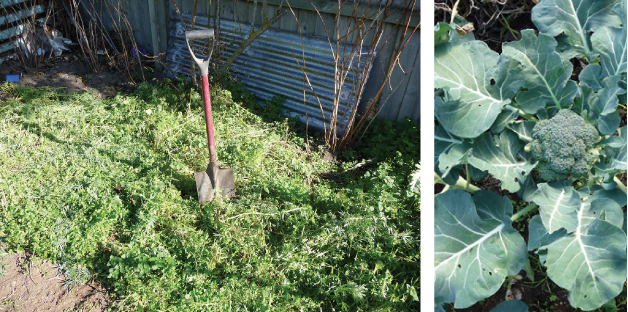Hei Mahi MāraMāra kai aroaromahana 2012
Oct 6, 2012

A beginner’s guide to growing organic vegetables
Nā Tremane Barr
Spring is my favorite time of year. As a gardener, I get to be outside in the sunshine and participate in the kaitiakitanga of ushering in the miracle of life as tiny seeds and seedlings start their new cycle in the whenua. The miracle of life has been on my mind a lot in recent months since I was diagnosed with Malignant Neuroendocrine Tumors (a type of cancer) in my pancreas and liver in late June.
Owing to the extensive nature of these tumors, the doctors say it is too late for surgery and as such the conventional medical system diagnosis is I have a terminal condition, albeit with five to 15 years life expectancy. However, I am very positive that I will have many more years of gardening left in me than that. Also, I will use a range of therapies to help achieve this goal.
My new situation has forced me to rethink what I need to plant in my māra this spring, because one of the new tools I am using to help revitalise my health is based on the blood type diet created by Dr. Peter J. D’Adamo. Dr D’Adamo is a noted naturopathic physician, researcher, lecturer, and author of the revolutionary Eat Right For Your Type series of books. His research and clinical testing on the connection between blood type, health, and disease concludes that each of the four main blood types
(O, A, B and AB) have particular foods that are beneficial, neutral or best avoided.
In general this can be summarised as:
- Blood type O thrives on a lean, high protein diet with vegetables.
- Blood type A thrives on a primarily vegetarian diet.
- Blood type B thrives on a mixed diet of meat, fish and dairy.
- Blood Type AB thrives on a modified vegetarian diet.
However, one of the key rules for all blood types is not to combine grains with animal and fish protein in a meal – only have meat and veges or grains and veges in a meal. I have an O blood type so normally just meat and veges is no hardship for me. However, with the tumour in my pancreas I am now on a very restricted diet that contains only seeds, nuts and vegetables. This is because my pancreas needs a rest from trying to secrete the enzymes necessary to help digest meat, oils and starchy grains.
As such, I am basically on a raw food diet with plenty of green vegetables, which means I need to focus on growing the vegetables most appropriate for my condition and blood type O such as kūmara, garlic, broccoli, artichokes, kale, kohlrabi, leeks, red onions, capsicums and peppers (eaten when red), parsley, pumpkin and spinach. Fortunately for my taste buds the neutral veges include tomatoes, most types of lettuces, and green and yellow capsicums. The “avoid” list includes most cabbages, red and white potatoes, cauliflower, sweet corn and Brussel sprouts, among others.

Kale
I will miss sweetcorn the most of the veges I have to avoid, and will confine my rīwai to a much smaller plot of the varieties with blue in them, while still growing other varieties for family members. This will open up space for the planting of the extra green vegetables that have added new meaning to the old saying: “Food is Life”. While I had a pretty reasonable diet before my diagnosis, I now have to make sure that this is especially true, even though sometimes the food tastes like grass when juiced.
A productive māra always has a plan from the outset. As I dig in the cover crops and spread compost and dolomite lime around, I sense what needs to be planted where, and how much space to allocate for the growing season. It always pays to plan ahead by leaving space for the autumn and winter vegetables that will have to be planted in early to mid-summer.
This spring I will also be trying to make room for Māori green vegetables identified in a new book by Tāhuri Whenua (the National Māori Vegetable Growers Collective). Korare is a concise summary of more than 30 traditional green vegetables including recipes, whakapapa, botanical and contemporary uses. It has great photos as well.

Left: Chopping up cover crop to be dug in; right: broccoli.
If you are living in Ōtautahi and you don’t have space at your own place or are looking to work in with others, then it might pay to get in touch with the Wai-ora Trust. The Trust has allocated 60 per cent more land for their 2012–13 Community Garden Plots, as part of its drive to encourage whānau and community groups to grow fresh vegetables. The Trust provides everything you need to succeed, including the land, seeds and plants, tools, knowledge and support, practical hands to help, plus monthly “how to” classes with useful cooking tips using seasonal vegetables. All you need to do is get a group of six dedicated friends or whānau who can commit to weekly attendance and work in the garden for at least one hour per week.
Thank you to those who entered the competition by answering the question: “What approach does Te Putahi farm follow in terms of its farm management?” While there were a few good guesses the person who gave the correct answer – mahinga kai me te ahuwhenua – was Suzi Flack from Karitāne. But as a bonus offering because I am feeling love for all living beings, all those who sent in answers will receive a copy of Grow Your Own Kai by Lisa Talbot.
Dr. Peter J D’Adamo’s Blood Type Diet
Wai-ora Trust
www.ahikakai.co.nz
Tāhuri Whenua (National Māori Vegetable Growers Collective)
To order a copy of Korare by Tāhuri Whenua (the National Māori Vegetable Growers Collective), contact Nick Roskruge at [email protected]